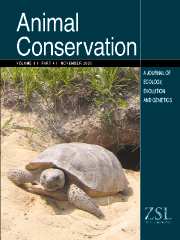Crossref Citations
This article has been cited by the following publications. This list is generated based on data provided by
Crossref.
Wilkinson, David M.
and
O'Regan, Hannah J.
2003.
Modelling differential extinctions to understand big cat distribution on Indonesian islands.
Global Ecology and Biogeography,
Vol. 12,
Issue. 6,
p.
519.
Yamaguchi, Nobuyuki
Cooper, Alan
Werdelin, Lars
and
Macdonald, David W.
2004.
Evolution of the mane and group‐living in the lion (Panthera leo): a review.
Journal of Zoology,
Vol. 263,
Issue. 4,
p.
329.
Luo, Shu-Jin
Kim, Jae-Heup
Johnson, Warren E
Walt, Joelle van der
Martenson, Janice
Yuhki, Naoya
Miquelle, Dale G
Uphyrkina, Olga
Goodrich, John M
Quigley, Howard B
Tilson, Ronald
Brady, Gerald
Martelli, Paolo
Subramaniam, Vellayan
McDougal, Charles
Hean, Sun
Huang, Shi-Qiang
Pan, Wenshi
Karanth, Ullas K
Sunquist, Melvin
Smith, James L. D
O'Brien, Stephen J
and
Craig Moritz
2004.
Phylogeography and Genetic Ancestry of Tigers (Panthera tigris).
PLoS Biology,
Vol. 2,
Issue. 12,
p.
e442.
Mazák, J.H.
and
Groves, C.P.
2006.
A taxonomic revision of the tigers (Panthera tigris) of Southeast Asia.
Mammalian Biology,
Vol. 71,
Issue. 5,
p.
268.
Xu, Y. C.
Fang, S. G.
and
Li, Z. K.
2007.
Sustainability of the South China tiger: implications of inbreeding depression and introgression.
Conservation Genetics,
Vol. 8,
Issue. 5,
p.
1199.
Hashem, Md. Abul
Bhandari, Dilip P.
Kang, Sung Keun
and
Lee, Byeong Chun
2007.
Cell cycle analysis and interspecies nuclear transfer of in vitro cultured skin fibroblasts of the Siberian tiger (Panthera tigris Altaica).
Molecular Reproduction and Development,
Vol. 74,
Issue. 4,
p.
403.
Christiansen, Per
2008.
Species Distinction and Evolutionary Differences in the Clouded Leopard (Neofelis nebulosa) and Diard's Clouded Leopard (Neofelis diardi).
Journal of Mammalogy,
Vol. 89,
Issue. 6,
p.
1435.
Piper, Philip J.
Ochoa, Janine
Lewis, Helen
Paz, Victor
and
Ronquillo, Wilfredo P.
2008.
The first evidence for the past presence of the tiger Panthera tigris (L.) on the island of Palawan, Philippines: Extinction in an island population.
Palaeogeography, Palaeoclimatology, Palaeoecology,
Vol. 264,
Issue. 1-2,
p.
123.
Li, Xuemei
Yeung, Leo W. Y.
Taniyasu, Sachi
Li, Ming
Zhang, Hongxia
Liu, Dan
Lam, Paul K. S.
Yamashita, Nobuyoshi
and
Dai, Jiayin
2008.
Perfluorooctanesulfonate and Related Fluorochemicals in the Amur Tiger (Panthera tigris altaica) from China.
Environmental Science & Technology,
Vol. 42,
Issue. 19,
p.
7078.
Kitchener, A. C.
and
Rees, E. E.
2009.
Modelling the dynamic biogeography of the wildcat: implications for taxonomy and conservation.
Journal of Zoology,
Vol. 279,
Issue. 2,
p.
144.
Driscoll, Carlos A.
Yamaguchi, Nobuyuki
Bar-Gal, Gila Kahila
Roca, Alfred L.
Luo, Shujin
Macdonald, David W.
O'Brien, Stephen J.
and
Brembs, Björn
2009.
Mitochondrial Phylogeography Illuminates the Origin of the Extinct Caspian Tiger and Its Relationship to the Amur Tiger.
PLoS ONE,
Vol. 4,
Issue. 1,
p.
e4125.
YAMAGUCHI, NOBUYUKI
KITCHENER, ANDREW C.
GILISSEN, EMMANUEL
and
MACDONALD, DAVID W.
2009.
Brain size of the lion (Panthera leo) and the tiger (P. tigris): implications for intrageneric phylogeny, intraspecific differences and the effects of captivity.
Biological Journal of the Linnean Society,
Vol. 98,
Issue. 1,
p.
85.
Rozhnov, V. V.
Sorokin, P. A.
Naidenko, S. V.
Lukarevskiy, V. S.
Hernandez-Blanco, H. A.
Litvinov, M. N.
Kotlyar, A. K.
and
Yudin, V. G.
2009.
Noninvasive individual identification of the amur tiger (Panthera tigris altaica) by molecular-genetic methods.
Doklady Biological Sciences,
Vol. 429,
Issue. 1,
p.
518.
Elith, Jane
and
Leathwick, John R.
2009.
Species Distribution Models: Ecological Explanation and Prediction Across Space and Time.
Annual Review of Ecology, Evolution, and Systematics,
Vol. 40,
Issue. 1,
p.
677.
Kitchener, Andrew C.
and
Yamaguchi, Nobuyuki
2010.
Tigers of the World.
p.
53.
Sunquist, Mel
2010.
Tigers of the World.
p.
19.
Mazák, Ji H.
2010.
Craniometric variation in the tiger (Panthera tigris): Implications for patterns of diversity, taxonomy and conservation.
Mammalian Biology,
Vol. 75,
Issue. 1,
p.
45.
Johnsingh, A.J.T.
Pandav, Bivash
and
Madhusudan, M.D.
2010.
Tigers of the World.
p.
315.
Barlow, Adam C.D.
Mazák, Ji
Ahmad, Ishtiaq U.
and
Smith, James L.D.
2010.
A preliminary investigation of Sundarbans tiger morphology.
mamm,
Vol. 74,
Issue. 3,
p.
329.
LUO, Shu‐Jin
JOHNSON, Warren E.
and
O'BRIEN, Stephen J.
2010.
Applying molecular genetic tools to tiger conservation.
Integrative Zoology,
Vol. 5,
Issue. 4,
p.
351.


